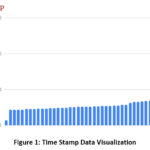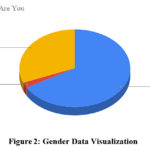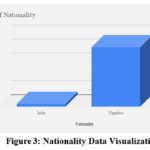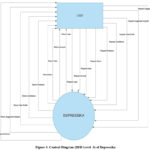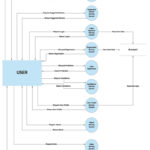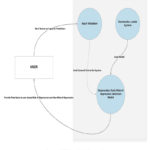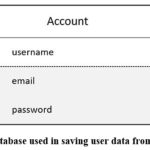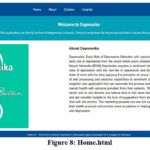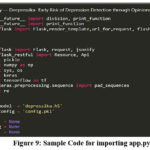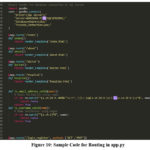Introduction
Depressika: An Early risk of Depression
Detection through Opinions is based on identifying early risks through
sentiments of social media such as twitter posted by the users. Approaching
this problem demands powerful techniques such as learning a powerful subset of
machine learning algorithms identified as the neural networks. Depressika
requires a sentiment classifier that categories or classifies early risks of
depression with the non-risk of depression and the percentage visualizer that
clarifies the state of mind. Social media and upon analyzing it, if high-risk
features are identified, then the web application supports mapping those
patients towards medical homes and doctors’ profile with the data applying the
principles of neural networks and understanding the maturity of text processing
and analytics capabilities in sentiment classification. Neural networks mature
the handling of sequential data in the aspect of early risk of depression for
health care providers in automating of time-consuming tasks. Text analytics is
one of the most beautiful branches of data science and artificial intelligence
which is contributing to the world by making people’s lives better and easier.
Today most powerful algorithm supports automation of tasks with increased
accuracy and optimization and among the top contributors, neural networks drive
ground-breaking techniques to leverage the power of big data in the medical and
health care domain.
Background of the Work
The work starts its roots in understanding depression and its types
which is prevailing in this world. Peoples are defying reality and consciously
living in the unreal, imaginary, hallucinatory state of mind and lost hope and
faith that leads to the identification of depression and ends with taking their
imaginary life not to be true. This problem leads to suicide and is faced by
one-third of the population in the world. Another state of the awareness might
be true but from the analysis of the human mind this state of mind keeps on
fluctuating, but these roots progress rapidly which in the case is the lack of
reality of the external world which is frequently termed as depression in a
medical encyclopedia.
Machines have been an integral part of life in today’s world,
especially computers. The Association of Computing Machinery [ACM] definition
of computing is any goal-oriented activity, which requires, benefits from
computers or creating computers (Machinery, 2005). This definition is the accepted
direction of machines and their computations. Machine Learning [ML] is a
technique to analyze data that automates the building of the Analytical models (SAS, 2019). ML is born from the pattern
recognition and with the idea that computers can learn from data, can identify
patterns and make informed decisions by the theory stating, computers can learn
anything without being explicitly being programmed to perform specific tasks
such as Early risk of depression detection with improved performance over time.
There are mainly two approaches in machine learning such as Supervised Learning
[SL] and Unsupervised Learning [UL], but recently Semi-Supervised Learning
[SSL] and Reinforcement learning have emerged but for the scope of Depressika,
we limit our exploration till supervised learning for predicting depression
from the opinions of social media. Out of many ML approaches, Deep Learning
[DL] is one of the techniques to achieve human-level accuracy in building and
running models (SAS, 2019). DL sets up demanding
parameters of the data and trains the machine to think like a human-brain and
learn as directed with the type of learning by identifying patterns using many
layers of processing known as the hidden layers. In this work, we apply deep
learning algorithms for predicting the mental health state of the users because
this technique is necessary for mission-critical sensitivity like the health
care domain. Recurrent Neural Network [RNN] is an algorithm of deep learning, a
subset of Machine Learning which is fully capable of identifying and detecting
any kind of disease from a sequential data such as texts and speech. It is on
the ground of an input layer, a hidden layer, and an output layer. The input
layer when passed the input, many hidden layer processes then the output is
received. Each hidden layer has its own weights and biases with their
activations, which enables neurons to behave independently, and the main
objective is to understand the correlations of the input(Dishashree gupta, 2017).
Problem Context
Understanding human life
itself is a mystery. It is the main evidence due to its unlimited potential to
grow and progress. The mind has infinite potential and capabilities to process
unlimited information that needs to be stress-free, but we are suffering from
not knowing its potential and despite knowing this we are not able to process
it.
(America, 2019) The mind constantly endeavors for finding the reality and truth but
most of the time we live in an illusion and lack of reality that dwindles our
thought processes. We get caught up in some aspects of our memory basically on
sad memories losing hope and faith that could come up as a dangerous disability.
This disability is causing major issues in healthcare. Peoples are even ending
their lives due to mental disabilities and depression is on the top of the list (booker, Cory, Jon
Greenberg, 2019 March 21st).
Today one-third of the
population is suffering from one or some kinds of mental difficulty. To be
exact 322 million till date are suffering from depression (ADAA, 2018). Depression is an inability to understand things as it is. It is a sense
of feeling of worthlessness, inability to contact with the human and social
interactions (Ritchie, 2018). From the famous celebrities, politicians to the scientist, namely
Abram Lincoln after his son died went into depression, J.K Rolling before
writing Harry Potter Manuscript went into depression, Angelina Jolie caught up
with depression but came out after social and community services, similarly
Charles Darwin got depression but managed to get out of it. Shah Rukh Khan got
depression when he suffered from the tragedy in 2010, Sir Isaac Newton also got
depressed but came out of it and became successful in their journey (Safal Stories, 2018
February 26). They have gone through depression once in their lifetime. It is a
self-consuming behavior where a patient is always in a low mood, frustrations,
and lack of enjoyment in life. The feelings of the gut have fallen and
suffering and battling with self on the mind and not understanding the world as
it really is. This is frequently identified when a person suffers from loss of
sleep, inability to eat, study and enjoy life for more than two weeks (Health, 2016). This is a Major Depressive Episode in Medial Encyclopedia.
Rationale
An early risk of depression detection by
opinions ‘Depressika’ will become an
insightful web application that can automate the process and assist doctors in
detecting their patient’s mental health with opinions provided from their
patients. This application will be able to reduce the hectic wait to visit
doctors and reduce time in dull tasks like filling up forms and people can
contact and get valuable insights in the form of suggestions from doctors
online enabling on the face to face chat with the doctors. The marketing
peoples can use this system to provide the recommendations to their health
products and provide value to patients in helping with their treatment process
if classified with depression.
Potential Benefits
Tangible Benefits
This application is to automate the task of Doctors in diagnosing their patients so that they can avoid hectic queues.
Enables the recommendation and suggestions from the doctors for time-saving treatments from where they are.
‘Depressika’ web application will be able to show the levels of depression in the percentage so that it becomes easy for doctors to recommend the strategies for treatments.
Contribute Technology on automating psychological areas.
Intangible Benefits
To master Deep Learning and Natural language processing concepts and techniques
To gain practical skills in building a model and web applications
To further progress in higher studies professionally.
Contributing to the process of computational psychiatry.
Easy interaction with the patients and better-quality healthcare provided.
Gain trust from patients and recommend products and suggestions.
Increase in technological awareness among health care providers.
Target Users
The survey form is
distributed to various categories of the users such as General Public including
students, The Doctors, and Mental Health professionals and Information
Technology Professionals to gain insights for future improvements as well as
obtaining new reflections and know the best value use case of the system. The
primary users would be the Doctors and Mental health professionals who can use
for automating their productivity. The Secondary users are the General Public
including students who can gather facts about their current mental state and
the third category includes the Information technology professionals who can
refer to this system as for learning and optimizing purposes. The data will be
analyzed, and improvements will be made based on their feedback and opinions. The
Questionnaire is to prepare among 50 persons who are interested in
Computational Psychiatry.
Aims and Objectives
The paper aim to provide the Web Application of early risk of depression detection based on Machine Learning Application with high accuracy. The objectives of this work are
1.To study and Analyse various types of depression with the collection and analysis of various opinions from social networks.
2.To study on various types of Machine Learning Algorithms and to extract distinguished features of depression using Machine Learning.
3.To develop a depression classifier model using the Machine Learning Algorithms.
4.Design a web application to detect depression based on features extracted and integrate it into a web application with Depression classifier model.
Literature review
Study and Analysis of Depression and its Types
Depression is widely common and critically
serious mental illness that negatively affects how a person feels, the way that
person thinks of, and the way of actions performed by that person. A person
faces variety of functions at work or at home. For instance, it can be one
person whom he thinks about every time or some work relatable which he commits
doing it, but due to some negative influence, he blames himself for those
regrets and fills his heart with guilt and misery. He tries to seek the help of
surrounding peoples in his environment about the negativity he has published in
his own life the world around and those moments become the part of his daily
living. He cannot accept the reality and seeks more unacceptance to the
situations with which he attracts more unpleasant and ultimately with those bad
and unhealthy living standards and accepts that he has lost all the abilities
to think far ahead leading to failures to everything. He hears the society
criticizing him and he adopts to the illicit way of life, losing interest in
regular tasks and all the hopes, hobbies blaming everyone, complaining the
state of his existence which he cannot come out. He wins or loses the battle
against his own survival and state of being, though he does not admit being
depressed. When a family member acknowledges his state of stress, frustrations
he is living with, it has become too late because he attempts to quit the faith
and ends his life with those memories. This story is of a man who has been very
dear to my family (name not disclosed). There are 12 most common types of
depression ( Ranna Parekh, M.D.,
M.P.H., 2017 January).
Sentiments
The Merriam Webster
Defines sentiments as an attitude, thought or judgement promoted by feelings, a
specific view or notion or a refined feeling, sensibility especially as
expressed in a work of an art or an emotional idealism, a romantic or nostalgic
feeling verges, an idea colored by emotion and the emotional significance of a
passage or expression as distinguished from its verbal context (Merriam Webster, 2019 ).
The Oxford English Dictionary defines sentiments as a view or opinions that is held or expressed, a
general feeling or opinions, a feelings or emotions, expression of view or
desire specially as formulated, exaggerated and self-indulgent feelings of
tenderness, sadness or nostalgia (English Oxford Living Dictionaries, 2019).
Similarly, Cambridge English Dictionary defines sentiment as a feeling about a
situation, or a way of thinking about something. It is a noun, meaning that it
is related to the existential identity of someone with the verge of interest in
a way of life and how things are done. There are various opinions about the sentiment
itself and let us stick to the basics of sentiments which is to know what it
is, how is it said and what do these means.
Deep Learning as Feature Learning
Adding scalability
with the ability to perform automatic feature extraction from raw data (Jason
Brownie, 2017 july 19)
is another cited benefit of deep learning model called as feature learning. The
notable scientist Yoshua Bengio started out with the strong interest in the
automatic feature learning (Jason Brownie, 2017
july 19) that large
neural networks can achieve. Yoshua
elaborated perspective of deep learning methods to aim at learning features
from higher levels of the hierarchy formed by the composition of lower level
features where automatically learning features (Jason
Brownie, 2017 july 19)
at multiple levels of abstraction allow a system to learn complex functions
which maps input to the output directly from the data, without depending on
hand crafted features (bengio, 2009).
Yoshua describes deep learning as the algorithmic ability to explore unknown
structures in input for discovering good representations with higher level
learned features defined in terms of low-level features (Bengio, 2012).
Deep Learning as Artificial Neural Networks
Geoffrey Hinton is a
pioneer (The Royal Society,
2019) in the field
of artificial neural networks and co-published the first paper on the backpropagation
(Jason Brownie, 2017
july 19) algorithm for
training multilayer perceptron networks. He describes deep as the development
of large artificial neural network. He describes an approach to training deep
as in a many layered networks of restricted Boltzmann machines ( (Salakhutdinov, 2009 april 15) (Hinton, 2006))
where we derive a fast, greedy algorithm that can learn deep, directed belied
networks one layer at a time, provided the top two layers from an undirected
associative memory. An undirected deep network was well received by the
community because they were successful examples of greedy layer-wise training
of networks allowing may more layers in feed-forward networks. The “deep”
describes their approach to in starting weights which allows deep auto encoder
networks to learn low-dimensional codes that work much better than principal
components analysis as a tool to reduce the dimensionality of data. He commented
that deep belief networks were the start of deep learning in 2006 and that the
first successful application of this new wave of deep learning was to speech
recognition in 2009 (Abdel-rahman Mohamed,
2006) achieving the
state of arts results. (Brownie, 2019-May-7)
Deep Learning as Scalable Learning across
domains
(Brownie, 2019-May-7)
Yann LeCun is a father of the network architectures that excels at object
recognition in image data called the convolutional neural network (CNN). This
technique scales with data and model size and can be trained with back
propagation (Jason Brownie, 2017 july 19).
His definition of deep learning as the development of very large CNNs, which
have great success on object recognition of photographs. He defines deep
learning as a pipelines of modules all of which are trainable, deep because it
has multiple stages in the process of recognizing an object and all of those
stages are part of the training (Accelerating Understanding: Deep Learning,
Intelligent Applications, and GPUs, 2016, Jan 21).
(Brownie, 2019-May-7)
Jurgen Schmidhuber is the father of another popular algorithm called the Long
Short-Term Memory Network (LSTM), a type of recurrent neural network that very
much like CNNs and MLPs, scales with model size and dataset size and can be
trained with backpropagation but is instead tailored to learning sequence data.
Schmidhuber interestingly describes depth in terms of complexity (Brownie,
2019-May-7)
of the problem rather than the model used to solve the problem (Schmidhuber, 2014, october 8).
Analysis of Data
Generic
Data Analysis
In generic data
analysis, the general information for the population is sampled and find which
background of peoples are mostly interested in computational psychiatry and
that the profile for the Depressika is well defined.
Time Stamp
Finding
This time stamp is new
information that generated while survey. The time stamp shows the active hours
of peoples in social media and the time people make out of their busy schedule
in order to check on the current trends in their feed. This signifies that social
media data are indeed useful for finding peoples state of mind and peoples are
contributing to generate data more during the peak hours of usages mostly after
5 PM in the evening.
Gender Data Visualization
Finding
The survey showed
mostly male are interested in knowing analytics and technology while some
people prefer not to share their gender at all. From reviewing the past data
for Women in Technology, women are showing trends of familiarity with the
technology.
Nationality
of people in survey
Finding
The responses mostly
came from inside the country This information is vital because the Depressika
is going to create value for Nepalese community and it is primarily targeted to
be developed for Nepalese psychiatrists and mental health professionals currently
researching and practicing in Nepal.
System architecture
Architecture is the fundamental
organization (mitre, 2010 Feb 23) or a blueprint of a system assembling the
components, their relationships with each other and the environment with the
principles governing the design and evolution. In the systems architecting
lifecycle, the need is expressed into a concept development. The needs are
analyzed and transformed into requirements gathering. The next step involves
designing the conceptual frameworks, models and views with pushing the
development phase. After the development is done, the model or system is tested
and maintained for production. In software engineering, this set of steps is
known as waterfall methodology. The best practices in architecting the system
is based on ensuring, evaluating and constructing the solutions through the
system development methodology lifecycle.
Abstract Architecture
Depressika, is a machine learning
application which is aimed to predict risk of depression of the users by giving
it text to learn from. The text entered into the system is processed by the
classifier model that classifies the sentences into depressive and
non-depressive ones. Each sentence is broken into words and words are
vectorized for the machines to learn from. The clutters from texts are cleaned
by the classifier model then trained using the recurrent neural network model. The
validation specifies the system to predict the text is depressive or
non-depressive, which informs users into the risk of depression. The system
displays the confidence of its prediction and builds the pie chart showing the
positive and negative opinions the user shares. The system shows the hospital
and doctor recommendations if the depression levels are too high and the user
can select the depression information page to learn more about depression. Each
user records are stored in the database so the user can simply login into the
system. Depressika is the Deep learning recurrent network model which is
trained and tested to correctly classify depression from the textual data.
System Design
System Design is the systematic process of
designing the components, architecture and modules, various interfaces of
components and data that goes through the system. System Analysis is the
process of defining how the components interact to achieve the requirements of
the user. The main purpose of the system design process is to provide data and
information about the system and its components to assess implementation that
is consistent with architectural models and views of system architecture.
Architecture is the conceptual model which defines structures, behaviors and
views of a system. Modules are components which handles tasks in a system.
Components are the functions which makes up the module (Odhiambo Didacus, 2018-September-24). Data is the flow of
information which assembled makes up the complete system.
SSADM
Structured Systems
Analysis and design Method (SSADM) is a systems approach to the analysis and
design of information systems, produced for UK government office focused with
the use of technology in government in the 1980’s being a discipline within the
software development industry that seeks to provide a framework for activity of
capturing, storing, transforming and disseminating information as to enable
economic development of computer systems that fit as per requirements (Select
Business Solutions, 2018).
SSADM is a waterfall method which an Information System design representing a
pinnacle of rigorous document led approach to design contrasting with Rapid
Application development. It is a type of implementation that builds of the
works of development methods and stages such as Feasibility stage, Requirements
stage, Requirements Specification stage, technical systems specification stage,
Logical system specification stage and physical design stage. The techniques
that are used in SSADM are Logical Data Modeling, Data Flow Modeling, Entity
Behavior Modeling (Select Business Solutions, 2018).
Context Diagram- DFD Level 0
The context diagram is used to establish
the scope of the system inside, outside and the relationship with the external
entities are modelled. It identifies the flows of information between the
system and eternal entities of the system (MIT , 2011 january).
Context Diagram
Data Flow Diagram Level 1
DFD Level 1 provides a more detailed
breakout of pieces of the context level diagram highlighting the main functions
carried out by the system on breaking down the high-level process of the
context diagram (Lucid Chart, 2018).
DFD Level 2
DFD Level 2 goes deeper into parts of Level
1 requiring more texts to reach the necessary level of detail about the systems
functioning. These details enable developers and designers to use to write the
pseudocode which supports the development of the actual code.
Database Design
Database design is the collection of
processes that provides simplicity to design, develop, implement and maintain
the data management and systems. This produces database systems to meet
requirements of users with enhanced high performance. Database are designed to
produce logical and physical models that proposes the database design. Database
design goes through requirement analysis phase which involves planning and
system definition leading to database designing phase involving logical and
physical models to implementation phase involving data conversion and loading
and testing. The techniques involved in designing database are normalization
and ER modelling (Guru 99, 2018). In Depressika, only
registration uses database to store, retrieve and present information to the
users so account table is created to store username, email and password of the
registered user.
Database Used
Database Table Structure
Table 1: Data
Dictionary of Depressika in Account Database
| Attribute Name | Data Type and Size | Primary Key | Foreign Key | Unique | Example |
| fullname | Varchar (50) | Yes | No |
No
| abhushan chataut |
| email | Varchar (100) | No | No |
No
| abuchataut@gmail.com |
| password | Varchar (50) | No | No |
No
| abhushan123 |
Implementation
Screenshots for home Page (Home.html)
Description
This is the Home Page
of the Depressika web application where the information of the system is
provided so that users have the options to be more aware of Depressika
application, depression, Doctors working for prevention of depression and
suggested hospitals for treating depression. The user can log-in or register
into the system to find their level of depression and take necessary actions.
From the home page, the users are directed to log-in into the system and enter
the opinions to identify depression. This system is for the prevention of
mental health disorders before they become prevalent and take necessary actions
to stop them before happening.
Sample Code
Written for app.py for Importing Necessary Packages
Sample Code for
Routing app.py
Critical Evaluation
The implemented application of natural
language processing in detecting depression from texts allows users to respond
to the health threats and minimize it by preventing it. The classification of
opinions into depressive and non-depressive helps users to understand their
mental health better and learn the most effective prevention mechanism by
gaining more information and building knowledge from it. Nepal has seen
uptrends in the depressive symptoms among students sue to the pressure and
stress which leads to serious hazards. Peoples are more likely to suffer from
depression especially in the urban areas due to lack of proper interaction
among fellow human beings. Depressika allows to check depression levels from
texts like they enter towards the social media such as Facebook or Twitter.
This system can calculate the percentage of Depression and can form insights
toward what to do next if the user is in risk of Depression. The hospital
suggestion options allow to search nearby hospitals for ease of getting treated
and suggested doctors allows to know the doctors before they book and
appointment. The about depression options provides information on depression
and depressive episodes so they can learn better and prevent depression better.
Reflection
The insights creating
process drove me to this extend of understanding wisdom and provided me with
satisfying me deeply with the science I wanted to develop and learn with
solving the related problem that is surrounding me and my known ones. I became
able to variate between alternatives and not getting shucked on a single set of
thoughts or beliefs that dosent even matter. For Depressika, there were mostly
psychological problems which I wanted to identify myself and learn from it and
try to prevent others from getting it. with the beautiful algorithm of
recurring neurons, which is able to control the state of being and develop deep
appreciation over my life and the ones surrounding me. I saw technology as a
solution to the depressive behaviors and constant mood swings. As an Early Risk
detection of depression detection through opinions, the opinions are the things
which I always struggle with, always worry about the social isolations and
always seeking for something that I need. The thing I got from this research
and information technology made my life turning to the other direction. Now I
see hope and it instills me deeper and these improvements to the extent of
progress and learning with love towards my fellow beings. The greatest relief
that is a true essence of joy and satisfaction and now with all these sentiments,
there must be some use of it.
Conclusion
The ability to perform
a research work on developing Early Risk of Depression detection through
opinions using a Recurrent Neural Network has been completed. The foundation
concept on the process of performing a research-oriented software development
has been collected. I have a deep appraisal and gratitude for those pioneers
who have devoted their entire life on discovering and inventing this science.
In this research, the works created by those scientists has been understood and
discussed to build on and reach the investigation goals step by step. In any
research the first phase is a data collection about the problem or goal that is
to be established. In Early Risk of Depression detection system, the very first
step has been collecting the problems and similar systems that help understand
about the dataset to collect and the tools and techniques to use after the
collection of desired datasets. Following by the way those pioneers used those
tools and techniques to real-world dataset to challenge, attack and solve those
related problems. This research helped me to understand the intricacies and the
way of doing the work of the Technology and product-oriented Software
development.
Future Enhancement
With all the demands
being fulfilled, there are further improvements and enhancements to the
research. The first things to be enhanced on is an approach can go with the
automation approach in development and the foundational concepts to go for
advancements. The approach in developing portfolio and learning machine
learning and using deep neural networks and deploying it on various types of
problems. For Depressika, all of the objective has been fulfilled and advancing
on these concepts would be the future enhancement of this research and I would
love to explore in areas of pratical analytical learning and growing on it till
I master it. The system can be upgraded into booking an appointment with
doctors and hospitals from the classified results. Searching hospitals and Doctors
in map to find their information to reach out to them and having one on one
query to them using call or chat button. In advanced model development, speech
and image processing functions can enhance ability of the system t perform
better and optimize it completely to better suit it for production purposes.
The research growth into other areas of natural language processing such as
speech and sound generation using generative recurrent unit algorithms to be
explored and research in domains other than health is to be explored and make
use of data that is generated.
Acknowledgement
The authors
acknowledge Lord Buddha Education Foundation (Asia Pacific University of
Technology & Innovation) for providing us the opportunity to work in this
research.
Funding
Nil
Conflict of Interest
Nil
References
- Ranna Parekh, M.D., M.P.H., 2017 January. American Psychiatric Association, Depression : What is Depression?. [Online]
Available at: https://www.psychiatry.org/patients-families/depression/what-is-depression [Accessed 12 May 2019]. - Abdel-rahman Mohamed, G. E. D. a. G. H., 2006. Acoustic Modeling using Deep Belief Networks. IEEE TRANS. ON AUDIO, SPEECH, AND LANGUAGE PROCESSING.
- ADAA, 2018. Anxiety and Depression Association of America. [Online]
Available at: https://adaa.org/understanding-anxiety/depression - America, M. H., 2019. Online Depression Screening: Data and Statistics. [Online] Available at: http://www.mentalhealthamerica.net/online-depression-screening-data-and-statistics [Accessed 22 march 2019].
- Bengio, Y., 2012. Deep Learning of Representations for Unsupervised and. JMLR: Workshop and Conference Proceedings, Workshop on Unsupervised and Transfer Learning, Issue 27, pp. 17-37.
- booker, Cory, Jon Greenberg, 2019 March 21st. Politifact. [Online]
Available at: https://www.politifact.com/truth-o-meter/statements/2019/mar/21/cory-booker/farmer-suicides-high-great-depression-no-data-says/ [Accessed 1 April 2019]. - Browniee, J., 2016. Machine Learning Mastry. [Online]
Available at: https://machinelearningmastery.com/sequence-classification-lstm-recurrent-neural-networks-python-keras/ - Brownie, J., 2019-May-7. Machine Learning Mastry. [Online]
Available at: https://machinelearning mastry.com/what-is-deep-learning[Accessed 11 5 2019]. - Dishashree gupta, 2017. Analytics Vidhya: Fundamentals of Deep Learning – Introduction to Recurrent Neural Networks. [Online] Available at: https://www.analyticsvidhya.com/blog/2017/12/introduction-to-recurrent-neural-networks/[Accessed 02 05 2019].
- English Oxford Living Dictionaries, 2019. Sentiment. [Online]
Available at: https://en.oxforddictionaries.com/definition/sentiment
[Accessed 14 may 2019]. - Guru 99, 2018. guru 99: Database Design Tutorial: Learn Data Modelling. [Online] Available at: https://www.guru99.com/database-design.html[Accessed 25 September 2019].
- Health, N. I. o. M., 2016. Depression basics. [Online]
Available at: https://www.nimh.nih.gov/health/publications/depression/index.shtml#pub1 - Hinton, G. a. S. R., 2006. Reducing the dimensionality of data with neural networks. science, 313(5786), pp. 504-507.
- Jason Brownie, 2017 july 19. Machine Learning Mastry: What is deep Learning?. [Online]
Available at: https://machinelearningmastery.com/what-is-deep-learning/
[Accessed 14 05 2019]. - Lucid Chart, 2018. Lucid Chart: What is the Data flow diagram. [Online]
Available at: https://www.lucidchart.com/pages/data-flow-diagram
[Accessed 24 September 2019]. - Merriam Webster, 2019. Sentiment. [Online]
Available at: https://www.merriam-webster.com/dictionary/sentiment
[Accessed 10 May 2019]. - MIT , 2011 january. MSC-IT study material. [Online]
Available at: https://www.cs.uct.ac.za/mit_notes/software/htmls/ch06s06.html
[Accessed 23 september 2019]. - mitre, 2010 Feb 23. miter:Systems engineering guide. [Online]
Available at: https://www.mitre.org/publications/systems-engineering-guide/se-lifecycle-building-blocks/system-architecture
[Accessed 10 August 2019]. - Odhiambo Didacus, 2018-September-24. Medium: The Andela Way: System Design in Software Development. [Online]
Available at: https://medium.com/the-andela-way/system-design-in-software-development-f360ce6fcbb9
[Accessed 17 September 2019]. - Ritchie, M. R. a. H., 2018. Mental Health. [Online]
Available at: https://ourworldindata.org/mental-health#anxiety-disorders - Safal Stories, 2018 February 26. Famous Personalities who suffered from depression and came out of it. [Online]
Available at: https://safalstories.com/archives/2779?fbclid=IwAR39Dftpgqoic7ZF2HJMgHFHIZ3h3BM6vQ0UH2VZUHOMgAjX3lXox-gopiU
[Accessed 20 March 2019]. - Salakhutdinov, R. a. H. G., 2009 april 15. Deep boltzmann machines. Department of Computer Science, Issue 448-445, p. Artificial intelligence and statistics.
- Schmidhuber, J., 2014, october 8. Deep Learning in Neural Networks: An Overview. Technical Report IDSIA-03-14 / arXiv:1404.7828 v4 [cs.NE],p. 88.
- Select Business Solutions, 2018. Select business Solutions: Software and Services: what is SSADM. [Online]
Available at: http://www.selectbs.com/analysis-and-design/what-is-ssadm[Accessed 17 September 2019]. - The Royal Society, 2019. web archive./ geoffrey hinton. [Online]. Available at: https://web.archive.org/web/20151103005016/https://royalsociety.org/people/geoffrey-hinton-11624/
[Accessed 03 November 2019].

This work is licensed under a Creative Commons Attribution 4.0 International License.
 and Rabi Shankar Rouniyar
and Rabi Shankar Rouniyar